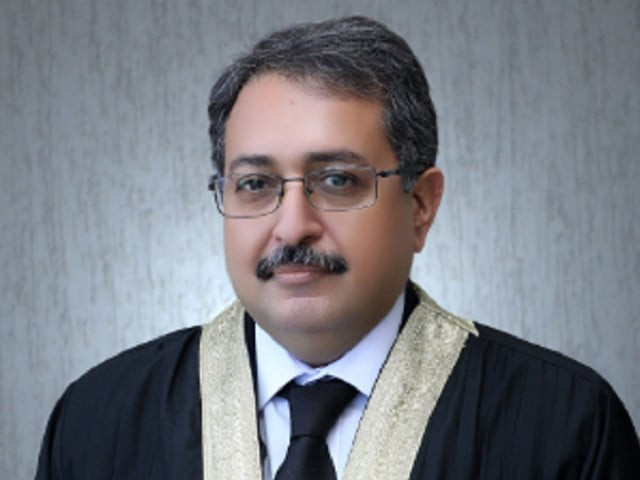IHC CJ accused of misusing authority
Justice Tahir authors 14-page judgment in Tyrian case

Three Islamabad High Court (IHC) judges have raised serious questions with regard to Chief Justice Aamer Farooq’s conduct and accused him of trying to ‘stifle’ the majority judgement in the Tyrian case by using administrative power.
On May 22, the IHC dismissed a petition seeking the disqualification of former prime minister Imran Khan for concealing his alleged daughter, Tyrian White. A three-member bench comprising Justices Tariq Mehmood Jahangiri, Arbab Mohammad Tahir and Saman Rafat Imtiaz took up the petition after a gap of almost a year. The court issued the order on the grounds that a three-judge bench had previously dismissed the petition.
"We hold that reconstitution of this bench as without lawful authority. Such reconstitution of the bench, after all members have rendered their judgments, is unprecedented. We cannot re-adjudicate an already decided petition. The earlier bench was comprised of three learned judges, wherein the opinion/judgment rendered by Mr Justice Mohsin Akhtar Kayani, J., agreed to by one of us (Mr Justice Arbab Muhammad Tahir, J.), dismissing the petition as not maintainable, commands support of the majority.
“The opinion of the majority was de-sealed in the open court, which shall be released to the parties. The same shall hold the field, obviously subject to an order of the court of appeal, if any," says the detailed judgement issued by three members of the IHC in the Tyrian case.
Justice Muhammad Arbab Tahir, while authoring the 14-page judgement, has noted that when “the matter is heard, arguments are concluded and the case is reserved for judgment, then the chief justice is divested of the power to transfer the case from one bench to another or reconstitute/dissolve such bench”.
“It is then regarded as use of administrative power to manipulate the outcome of a judicial proceeding.”
"In a nutshell, no power is vested with the learned chief justice to reconstitute a bench once it has been constituted, unless such a bench requests its reconstitution through a judicial order. The matter becomes more serious when the chief justice himself is a member of the bench.
He is then aware of the possible outcome of a judicial matter. It becomes even more serious when the learned chief justice authors a judgment and such draft is circulated to co-members of the bench while the co-members of the bench show disagreement with the opinion of the author/chief justice, render their own judgment and duly communicate the same to the chief justice."
The judgement said that the chief justice has observed in his note that the two members of the larger bench after receiving his draft judgment, without consulting him, sent their own signed judgment. Not agreeing with the opinion of the chief justice and expression of independent view is neither a sin nor violation of any settled practice. Judicial practices evolve for safeguarding the interest of justice, but these practices cannot cage independence of a judge to form an opinion in accordance with law as per his own conscience.
The learned chief justice had formed an opinion that the petition is maintainable, to which the other two members disagreed. The act of reconstitution of the larger Bench by the learned Chief Justice, after receiving separate judgment from two co-members of the Bench,
prima facie, qualifies as stifling the independent judgment of two co members of the Bench. The learned chief justice was free to express his own judicial opinion, but could not have blocked judgment of the majority by a single stroke of his pen on administrative side through reconstitution of the bench.
“In this case, the learned chief justice, being author of the minority view, could not have used his administrative power to suppress the judgment of the majority."
The judgment noted that the IHC chief justice was not vested with power to dissolve a bench of which he himself was a member, particularly at a stage when he himself had authored his opinion and shared the same with co-members of the bench.
"After receiving the signed judgment from the co members and realizing that his opinion is the minority, he could have pronounced judgment of the majority rather than blocking the same by way of withholding his already drafted opinion, belated recusal and reconstitution of Bench on the basis reference to some judicial norms.
"The opinion of the majority could not have been stifled. The Larger Bench comprised of three learned Judges including the Chief Justice and agreement of two of them on any legal point is the majority.
"The said judicial opinion/judgment of majority is in field with full force and cannot be nullified through an office note or issuance of a press release on administrative side by the Chief Justice in his administrative capacity. The judgments of the court are based on reasons and material available on record and not the speculations of uncertain characters. Such speculations cannot be allowed to divert the outcome of judicial matters through dissolution / reconstitution of benches."
The court also said that the cases pending before courts having political consequences are frequently debated upon in the mainstream print/electronic media as well as social media. Can we allow our judicial findings to be controlled by speculations of parties to a case or their proxies and ignore the mandate of law. Obviously not.
"If this court starts falling victim of such silly tactics, then we will be allowing evil minds to interfere with and engineer possible outcome of judicial matters, besides making it impossible for the Court to act as independent arbiter of disputes.
“Every litigant expecting unfavourable decision from a court would publicly level baseless allegations and influence the outcome of judicial proceedings including constitution/dissolution of Benches. If we set such precedents, it will erode public trust and confidence in the rule of law, administration of justice and independence of judiciary."
"Perusal of record further shows that before reconstitution of this Bench, one member of the earlier bench (Mr Justice Mohsin Akhtar Kayani, Senior puisne judge) had written two office notes (i.e., one addressed to Secretary to the learned Chief Justice and the other to the Registrar of this court) for issuance of cause list so that the bench reassembles for pronouncement of order of the court.
“It appears that the registrar failed to comply with such directions without any plausible explanation."
The judgment said that it is beyond comprehension that despite the repeated requests made in explicit terms by author of the majority judgment, the office failed to issue cause list for the pronouncement of the judgment, therefore, the judgment authored by Mr Justice Mohsin Akhtar Kayani, learned senior puisne judge, agreed to by one of us (Mr Justice Arbab Muhammad Tahir, J.), was uploaded on the official website of the Islamabad High Court upon their direction which, too, was taken down from the website without their prior approval or consent.
The judgment also said that the chief justice of this court is vested with power to “constitute” benches for hearing of matters coming before him. But the power once exercised, the chief justice cannot subsequently alter or modify the constitution of such a bench unless the matter is referred back to him through a judicial order.
"There is difference between “constitution”, “reconstitution” and “dissolution” of benches. This distinction has a very close nexus with the nature and stage of proceedings. If any member of a bench is not available or he has disqualified himself to hear such matter on any ground or the bench refers the matter back to the Chief Justice due to any reason for reconstitution of bench, then the chief justice regains the authority and can pass appropriate orders."
“Due to refusal of the registrar of this court to issue cause list despite written requests in terms of Order XX CPC by the learned senior puisne judge, the two members of the bench were compelled to release their judgment on the official website.
The release of the judgment of majority without the issuance of a cause list was not a “fault” or “lapse” but due to “defiance” of the registrar of this court".



















COMMENTS
Comments are moderated and generally will be posted if they are on-topic and not abusive.
For more information, please see our Comments FAQ